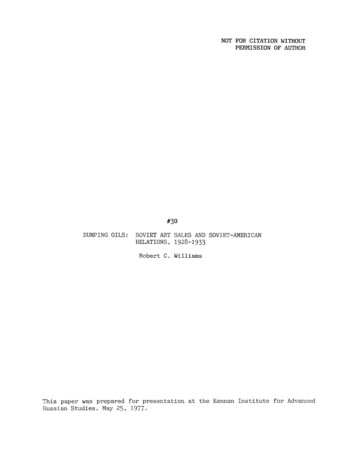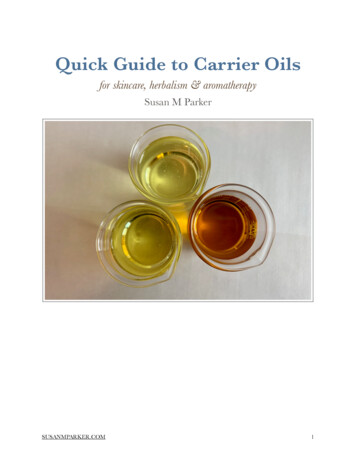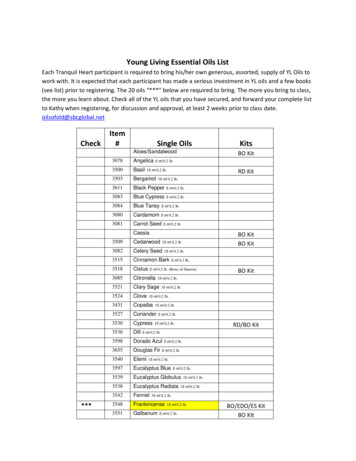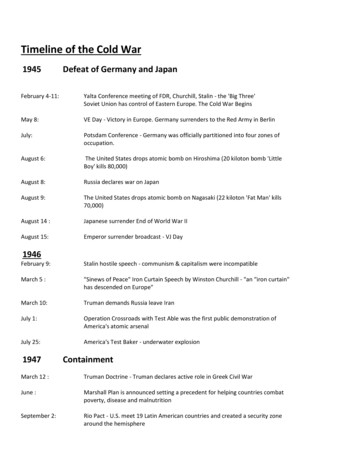
Transcription
NOT FOR CITATION WITHOUTPERMISSION OF AUTHOR#30DUMPING OILS:SOVIET ART SALES AND SOVIET-AMERICANRELATIONS, 1928-1933Robert C. WilliamsThis paper was prepared for presentation at the Kennan Institute for AdvancedRussian Studies. May 25, 1977.
DUMPING OILS: SOVIET ART SALES ANDSOVIET-AMERICAN RELATIONS1928 - 1933byRobertCBColloquiumMay 25, 1977Kennan Institute for Advanced Russian Studies, Woodrow WilsonInternational Center for Scholars, Washington, D.C.
DUMPING OILS: SOVIET ART SALES ANDSOVIET-AMERICAN RELATIONS1928 - 1933A report that Secretary Mellon has purchased VanDyck's "Portrait of Philip, Lord Wharton 11 wasauthoritatively denied here tonight. Mr. Mellonhas bought no pictures from Russian collectionsfor his art collection.Special to the New York TimesWashington, D.C., May 10, 1931It ls understood that you have authorized us topurchase for you certain paintings from theHermitage Collection in Petrograd, and that ifyou decide to retain them you will pay us acommission of 25% of the cost price.Carman Messmore, M. Knoedler & Co. ,to Andrew Mellon, April 24, 1930In 1930-1931 the U.S. Treasury Secretary, Andrew W. Mellon,accomplished one of the great artistic coups of all time. For the low,low price of only 6,654,052.94 he acquired from the Hermitage inLeningrad twenty-one European masterpieces which he later donated,with the rest of his paintings, to the National Gallery of Art inWashington/ D.C. The "Alba Madonna" by Raphael alone cost 1,166,400, the highest price ever paid for a single painting at thetime. Yet until Mellon's trial for tax fraud in 19 3 5 (he made the mistake of trying to claim his paintings as a charitable deduction on his
21931 income tax, was acquitted of fraud, but paid back taxes),Americans beard only rumors that such purchases had even been made.Mellon himself when he said anything at allIIsaid that he owned nosuch paintings, paintings which we now know were lodged securely inhis own apartment at 1785 Massachusetts Avenue or in the basement ofvthe Corcoran Gallery in Washington. Even the New York TimesIin aneditorial written in the summer of 19341 dismissed the idea of such atransaction as pure fantasy:If this is not the time when an American citizen would be likelyto buy the most expensive painting in the world 1 neither is it thetime when the Soviet government would be likely to sell the rarestof its national treasures. Selling off the family heirlooms by agovernment or individual is a sign of being hard up, and that isa:p impression which the Soviet regime at the present momentwould- not care to create abroad .1Yet the Times was as uninformed as most Americans. Not only hadMellon made such purchases, but the Soviet government was selling offmillions of dollars worth of art treasures abroad to help finance industrialization at home.The U.S. Treasury Secretary was Undoubtedly themost important client in these massive sales. But he was not alone.The great foreign Soviet art sales of 1928 to 1933 were onlyone part of a desperate official policy of forced exports designed tohelp pay for industrial imports during Stalin's First Five Year Plan,launched in 1928. The United States was a central target in this policy,since by 1930 American bus.iness firms had become major suppliers of
3industrial goods for the U.S.S.R., goods usually bought on credit. Byselling art in the American market, the Soviet government thus hoped toreverse an increasingly unfavorable balance of trade. The exchange ofAmerican tractors and machinery for Soviet timber, furs, hides, and .manganese, with its asymmetry of Soviet debts and American credits,had flourished in the late 1920's despite the absence of any formaldiplomatic relations. After the autumn of 1929, the trade relationshipwas more symbiotic. American industry often needed the Soviet marketduring the Depression as badly as the Soviet government neededAmerican industrial goods. Many businessmen believed that-Sovietpurchase orders could save American jobs.Historians generally agree that the United States finallyrecognized the Soviet government in November 19 33 because of threedevelopments: the 1931 Japanese occupation of Manchuria, whichprovided a common threat to both Russia and America in the Far East; theU.S. desire to reverse the concurrent shift of Soviet industrial purchasesto Germany, where credit was more readily available; and the election ofa Democratic administration more sympathetic to the Soviet Union. Yetfrom the Soviet point of view, recognition was the culmination of yearsof efforts in New York and Washington to encourage Soviet-Americantrade relations, often involving intense lobbying with high Americanofficials, from the sympathetic Senator William E. Borah to Mellon\
'.4himself. ·The exhibition and sale of art in the United States was acentral part of that campaign, n0t merely to earn desperately neededvaluta 1 but also to encourage the larger trade relationship incommodities other than paintings, jewelry I and antiques. In sellingpaintings from the Hermitage to wealthy Americans, Stalin was not onlyearning hard currency to pay for imported Fords on tractors, but winningcapitalist allies in high places.The fact that some wealthy American and European buyersacquired art from the Hermitage and other Soviet museums in the early1930's is now generally· known in the art historical literature, at leastin the West. 2 Yet this ·literature has usually stressed the role of thebuyer 1 not the seller, and has been more anecdotal than analytical. InSoviet literature 1 the topic is simply not discussed at all.Missingmasterpieces are generally attributed to a 1931 fire in the Hermitage orto subsequent German devastation; ih one case a Soviet publication of1950 mistakenly printed a photograph of Raphael's "Alba Madonna .without realizing that for twenty years it had been not in the Hermitage,but in Washington. 3 Only within the last decade has there been anoccasional Soviet comment regarding paintings once in the Hermitage.but now in Western museums. 4 Soviet art sales have also not beenlinked, as they should be, with larger strategies of Soviet foreignpolicy associated with a more benign attitude toward certain capitalist
\5countries: the Comintem shift toward the Popular Frpnt againstfascism; the disarmament campaign in the League of Nations; and thecampaign for American recognition. In fact, the Soviet art sales of1928-1933 were an integral part of Soviet foreign policy, especiallyas it pertained to the United States.IThe Soviet art sales of 1928-1933 reversed the traditionalflow of art from West to East. The Imperial Russiangovemm nthadbeen a buyer, not a seller, of art. Catherine the Great {17 63 .,.179 6) wasonly the first of many Romanov rulers whose agents fanned acres s Europein search of art to enrich the great Imperial collections of theH rmitage.Before World War I, Russia's private citizens were also avid buyers ofWestern art, among them wealthy Moscow merchants like Sergei Shchukinand Ivan Morozov, as well as the more solvent branches of the Yusupovand Stroganov families. In 1909 the Burlington Maqazine observed that11St. Petersburg is rich in pictures of old masters I for the most partunknown to art critics. nS But these pictures were rarely for sale.Around 1910 the British art dealer Joseph Duveen offered to buy thefamous "Benois Madonna" of Leonardo da Vinci from Madame Benois onthe recommendation of his appraiser, Bernard Berenson, but was outbidby Nicholas II, who bought it for the Hermitage. In 1911 thePhiladelphia collector P .A.B. Widener tried to buy two Rembrandt
6portraits owned by the Yusupov family, but discovered that they werenot for sale at any price; only after the Russian Revolution would hisson Joseph acquire them from an emigre family member in need of cash,Prince Felix Yusupov, the murderer of Rasputin. There were many truemasterpieces in the Hermitage; the 1912 catalogue featured a color.frontispiece of Rapr.ael'·s "St. George and the Dragon" (1504), acquiredby Catherine in 1772 from Louis Antoine Crozat, Baron de Thiers, andmany black-and-white photographs of the paintings later sold toMellon. 6 Until 1917 there was little question that the Hermitage wasa great museum whose works were not for sale.When it did sell art abroad, the Imperial Russian governmentwas not very successful. Russian paintings, sculptures, and bronzesusually formed a colorful part of the Ministry of Finance's many exhibitsat foreign trade fairs before World War I. In America they attractedgreat attention at Philadelphia in 1876, Chicago in 1893, and St. Louisin 1904. But these were usually works by contemporary Russian artists,not European masterpieces; the best ones were often only on loan, notfor sale, and were buried among the sealskins, sable, and woodproducts designed to attract the Western businessman. Moreover, in1904 the Russian art exhibit at St. Louishundred paintingsIIconsisting of more than sixmet disaster. The agent of the Ministry of Financeattempted to sell them in New York in 1906 without paying the tariff on
7imported art objectsIand had his entire collection confiscated by theBureau of Customs. After moving around from various warehouses inNew YorkIToronto, and San Francisco it was finally sold at publicIauction as "unclaimed merchandise" in February 1912, by order of theSecretary of the Treasury and approval of President Taft. 7 No furtherRussian government art exhibits were launched in America until twentyyears later, when the first Soviet art exhibit visited New York in early1924.Throughout the 1920's there were persistent rumors in theWest that the Soviet government was about to sell European masterpieces from the Hermitage and other art treasures from nationalcollections. In fact, the Hermitage was greatly enriched during thisperiod by the nationalization of private art collections. Until 1928 therumors remained simply rumors. In 1924 the head of the SoViet tradedelegation in London, F.I. Rabinovich, wrote that these rumors are11absolutely without foundation. The authorities of the Hermitage andother museums have not the slightest intention of selling any objects oftheir collections of art. u8 But by 1928 Stalin's industrialization drivemade the exporting of art objects to earn foreign currency not onlypossible, but necessary.11We were commanded in the shortest possibletime, u recalled one Hermitage curatorI"to reorganize the whole of theHermitage collection 'on the principle of sociological formations'.No
8one knew what that meant; neverthelessIunder the guidance of semi-literate 1 half-baked 'Marxists' who could not tell faience fromporcelain or Dutch masters from the French or Spanish, we had to setto work and pull to pieces a collection which it had taken more thanone hundred years to create. u9 As this particular curator 1 TataniaChernavina, soon discovered, reorganization was a prelude to foreignsales. In the spring of 1930 she was ordered to remain after hours inthe Hermitage1remove Van Eyck' s "Annunciation" from the wall,deliver it to a high government official, and hang another painting inits place. Unknown to her, the Mellon sales had commenced.The Hermitage itself had little to do.with these sales. Itsstaff generally carried out orders only with great reluctance, saddenedby the depletion of the collection, but fearful of the consequences ofresistance. The head of the West European Painting Section, V.F.Levinson-Lessing, found himself assigned in 1928-1933 as an artappraiser for the Soviet art export agency, Antikvariat, and to theSoviet trade representative in Berlin, the exchange point for most sales.But Lessing was not enthusiastic about his job, and thirty years laterwas perhaps the only Soviet scholar to allude in print to the veryexistence of foreign art sales. The man ultimately responsible for theHermitage and other Soviet museums, Anatoly Lunacharsky, Commissarof Education, also resisted pressure from Stalin to begin selling art
9works abroad. In 1930 he edited a book on Selected Works of Art fromthe Fine Arts Museums of the U.S.S.R. that ultimately proved to be thelast publication to include illustrations of such masterpieces asTitian s "Venus at the Mirror" and Velasquez's "Portrait of PopeInnocent X," both later sold to Mellon. On September 28 1 1928Lunacharsky persuaded the Armenian-born Commissar of Foreign TraderAnastas Mikoyan, to co-sign an order by the Main Customs Administration forbidding the export abroad of valuable art objects r includingpaintings by 11 artists whose production is systematically collected inthe museums of the U.S.S.R.," or works "necessary for the study ofthe general history of art." But Lunacharsky himself was under fire atthis time, and his efforts proved to be too little and too late. InNovember 1928, two months after the Customs order, the first Sovietsale of art abroad began at the Rudolf Lepke auction house in Berlinunder the direction of Lunacharsky' s valued co-signer, Mikoyan. 10The great Soviet art sales began in public in the autumn of 1928 underthe aegis of the Commissariat for Foreign Trade, Narkomvneshtorg, notthe Hermitage.
10ll·The decision to sell art objects abroad in the autumn of 1928was ultimately the Politburo's. But the principal agent was Mikoyan,and the principal selling mechanism the Commissariat of Foreign Trade.Mikoyan became Commissar in 1926; by the autumn of 1927 he wasalready exploring the possibility of foreign art sales through the Soviettrade representative in Paris, George Piatakov. Piatakov proposed a. commercial venture" to the well known French art dealer GermainISeligman, invited him to Moscow, and showed him great storerooms fullof crystal chandeliersImalachite tablesIjewelry and paintings. ButISeligman was more interested in recovering lost Watteaus and Matissesfor France, and the French government was justly suspicious of lawsuitsin French courts by Russian emigre former owners of art sold abroad. Thedeal fell through, although Seligman was told he could have a completelyfree hand in organizing auctions and deciding on the makeup and sequence f railroad car shipments of art to be sent his way from Moscow. 11Mikoyan then initiated the public auction sales in Berlin and Vienna inNovember 1928, but the works offered were not masterpieces, andWe terndealers knew it. Prices were low sales were disappointingIIand there was a lawsuit by Russian emigres claiming that the Sovietgovernment was selling stolen property rightfully theirs; their case wasupheld in Berlin 1 but overturned by an appellate court in Leipzig. When
11the public sales proved less profitable than anticipated, Mikoyandecided to negotiate private sales of the best works from the Hermitage.The American art market offered the best prospects 1 since forseveral decades wealthy Americans had been steadily draining Europeof some of its finest art and antique collections. Mikoyan thereforeturned to one of the few Americans he knew in Moscow, Dr. ArmandHammer.Hammer had come to Russia in the summer of 19 21 alongwith a number of other Americans associated with the "Bureau . in NewYork of the first Soviet trade representative, Ludwig C.A.K.Marte s.Hammer's father Julius 1 a well-to-do so cia list doctor and owner of adrug supply house, had worked for Martens in 1919 and helped establishthe first Soviet-American trading agency the Allied American CorporIation, an offshoot of Hammer's drug company which had been incorporated in Delaware in 1917. Hammer himself, through Martens,obtained a concession to mine asbestos in the Urals, and then in 1925another to manufacture pencils; in the meantime the Allied AmericanCorporation handled the sales of several dozen American companies,among them the Ford Motor Company, in Soviet Russia in the 1920's.Mikoyan and Hammer had known each other since 19 23, when Hammerarrived at Novorossiisk with the first shipment of Fords on tractors.Hammer 1 whose trading operations had largely been absorbed by theSoviet trading company Amtorg in New York after 1924, was thus an
12excellent contact with American busines.s sources. By the winter of1928-1929 it was also becoming clear that foreign concessionaireswere no longer welcome under the First Five Year Plan, and that theHammer pencil concession would soon be nationalized. Art objectsprovided an intriguing alternative commodity.The first Mikoyan- Hammer art venture was a failure. In late1928 Mikoyan hinted that works from the Hermitage were now for sale,and promised Armand and Victor Hammer a 10% commission on anypaintings they could sell in New York.They promptly wired theirbrother Harry to g et in touch with the world's leading art dealer, ·Joseph Duveen. Duveen, in turn, set up a syndicate of New York artdealers capable of raising sizeable sums of money, told his appraiserBerenson to get ready for a trip to Leningrad, and sent Antikvariat alist of forty Hermitage paintings for which the syndicate was preparedto pay five million dollars. Schapiro the head of Antikvaria t, wasIinsulted."What do they thing we are? Children? Don't they realizewe know what is being sold in ParisILondon, and New York? If theywant to deal with us seriously, let them make serious offers." Thisparticular arrangement fell through, but Mikoyan was still determinedto sell paintings in America. In 1929 he told the Hammers that "you
13can have the pictures now, all right. We don't mind if you take themfor a. while. But we will make a revolution in your country and takethem back. n 12The abortive Duveen negotiations were part of a more generalcampaign by the Soviet government to distribute and sell art objects inAmerica in 1928. The first of many Soviet art exhibits was launched inNew York that year by VOKS, the All-Russian Society for CulturalRelations Abroad (known to its critics as the Society for StuffingForeign Geese), working through.Amtorg. The principal Americanorganizer was a Philadelphia art critic, Christian Brinton, who hadsigned an agreement with VOKS officials in Moscow in the summer of1928 to arrange such exhibits and to sell contemporary and folk art fora 10%. commission. Eight such exhibits were held in New York and otherAmerican cities during 1928-1934, featuring icons, rugs, textiles, toys,woodenware and other objects now familiar to any visitor to Soviet bookoutlets. In 1929 Amtorg' s income from such sales amounted to more thanone million dollars, more than double the 1928 figure. In addition,Amkino, a subsidiary of Amtorg, supervised the shipment of Soviet filmsfrom Germany to the United States, among them Turksib, The GeneralLine, Potemkin, and ArsenaL None of these cultural efforts earned thecurrency equivalent to Mellon's paintings, but they had a considerable
14political value in preparing American public opinion for better tradeand diplomatic relations with the Soviet Union .13In 1929, having discovered that New York s best knovm artdealer was offering low prices for Hermitage paintings, Mikoyandecided to eliminate the middleman and sell directly to a fellowArmenian, Calouste Gulbenkian, head of the Iraq Petroleum Company.Gulbenkian was then a British citizen living in Paris, who had beenmost helpful, some said, in helping the Soviet government dump oilson the Western market. In 192 3 Gulbenkian, a noted art collector,haa also loaned Felix Yusupov a half million dollars with which to buyback his two Rembrandts from Joseph Widener (he failed). NowGulbenkian was interested in buying European masterpieces from theHermitage. This idea probably originated in 1928 in Paris duringconversations between Gulbenkian and Piatakov, Mikoyan' s tradedelegate there; ·in 1929 Piatakov returned to Russia to take over theState Bank, and Gulbenkian rema.tned in correspondence with him. ByJune 1929, with Piatakov 1 s aid, he had signed a,contract with Antikvariat to purchase his first works from the Hermitage: Dirk Bouts'"Annunciation," a Louis XVI writing desk, and twenty-four gold andsilver eighteenth-century French pieces."I am very interested inconcluding others, " Gulbenkian wrote Piatakov, "particularly becauseI am convinced that the prices I have already paid can be considered to
15be the highest obtainable. ul4 As in Gulbenkian' s later art purchasesthe objectswe eIpacked by Antikvariat officials in Leningrad under thewatchful eye of Gulbenkian' s agent, shipped on to the Soviet traderepresentative in Berlin, and exchanged for a bank draft in poundssterling, payable to the Soviet trade delegate in Paris.Despite continual haggling over prices, Gulbenkian bought a'number of objects from the Hermitage between the summer of 1929 andthe autumn of 1930. He had obuy; he wrote, because of 11 this passionwhich is like a disease" to collect art; but his hair was "growingwhiter" because of arguments over the prices. Still, by late May 1930Gulbenkian had purchased Houdon 's statue of "Diana n and six majorpaintings from the Hermitage: Rubens' "Portrait of Helene Fourment,"Rembrandes "Portrait of Titus, 11 and "Pallas Athene," Watteau's "LeMezzetin, 11 Ter Borch' s'- :-,,-.11Music Lesson, . and Nicholas Lancret' s "Les.Baigneuses." (Gulbenkian ultimately sold four of these to theWildenstein Gallery in New York, which in 1934 sold the Watteau to theMetropolitan Museum of Art).He later added Rembrandt's11Portrait ofan Old Man. " Having consummated hls purchases, Gulbenkian wrotePiatakov on July 31, 1930 that the Soviet art sales were really a greatmistake; "the objects which have been in your museums for many yearsshould not be sold," he maintained, adding that "the conclusion will bethat Russia is indeed in a bad way if you are obliged to get rid of objectswhich will not in
16the end really produce large enough sums to help the finance of thestate.11Do not forget," he admonished Piatakov, "that those fromwhom you would ask for credit are precisely the same as the potentialbuyers of the objects you wish to sell out of your museums. ulS Themost important source of foreign credit and potential art buyer, ofcourse, was Andrew W. Mellon.IIIWhile the private Andrew Mellon was buying art from theHermitage in 1930-1931, the public Andrew Melion, as U.S. TreasurySecretary, was dealing with a number of issues related to theunprecedentedly high levels of Soviet-American trade. Since the mid1920's the United States had become a major supplier of industrialgoods and raw materials to the Soviet Union: automobiles, truckstractors 1 nonferrous metals, cotton I and rubber.1Most of these saleswere made possible by long-tenn credits extended by Americancompanies to the Soviet trading agency in New York, Amtorg, representing Mikoyan' s Commissariat of Foreign Trade. Imports of fursIhides 1 lumber 1 and manganese from Russia were miniscule by comparison, so that an unfavorable balance of trade was developing. By 1930America was second only to Gennany as the major creditor of theU .S.S . R. The Soviet government desperately needed to reverse itstrade deficit with the United States.
17There is little doubt that the Soviet Union badly neededAmerican capital, technology I and engineering know-how under theFirst Five Year Plan. In 1929 Amtorg suddenly tripled its orders fromAmerican companies; in 1930Ame icanexports to Russia reached alevel nearly double that of 192 8. For the first time since the mid1920's, the United States replaced Germany as the major source ofimports for the U . S S . R.Isup plying 2 5% of the total of all importedgoods. The stock market crash of late 1929 I with its resultant bankclosings and massive unemployment, meant that from the Americanpoint of view 1 trade with Russia was even more desirable. In adepressed market, the Soviet government was a welcome buyer, andcompetition for Amtorg orders became fierce in the first half of 1930.Soviet-American trade reached an all-time peak of 114,399,000 thatyear, mainly because of U.S. exports .16 After that, the Soviets provedunable to pay for many goods, and in April 1931 turned to Germany forindustrial credits. ·Mellon's major headache in Soviet-American trade relations in1930-1931 concerned "dumping," Soviet sales of goods abroad at pricesbelow the "fair" market value.Mellon received a good deal of pressurefrom American businessmen to issue strict orders against Soviet dumping.at precisely the time when he was negotiating his Hermitage purchases.He bought his first paintings in April 1930; in May he issued an embargo
18- againstSoviet matches. In July 1930 he issued another embargoagainst any Soviet lumber involving the use of convict labor. BetweenJanuary and April 1931 Mellon consummated the greatest of hisHermitage purchases; in February he ruled favorably to the Sovietgovernment in the case of manganese dumping. Only on April 22, 1931did he impose a temporary embargo on Soviet asbestos, an embargopromptly lifted in April 1933 by the new Roosevelt administration.Throughout 1930-1931 Mellon proved a reluctant enforcer of theprotectionist will of Congress and many businessmen, as expresse ?- inthe Smoot-Hawley Tariff on June 1930. By the winter of 1931-1932 hehad been driven from office by the threat of impeachment, and soughtrefuge as Ambassador to the Court of St. James, blamed in large measurefor the Depression because of his previous policies. 17Mellon thus chose a propitious moment to buy his paintings.The Soviet government badly needed to sell goods in the American marketto balance its imports. Art objects were being sold in large quantity.During the January-September 1930 period the Soviet government sold1,681 tons of art objects, jewelry, and antiques abroad; of this, 117tons went directly to America, and more undoubtedly came indirectlythrough Europe.l8 These statistics d'o not even include the secretprivate sales to Gulbenkian and Mellon, whose value, after all, was inmoney rather than weight. In 1930 art was a crucial commodity with
19which the Soviet government wished to reverse an unfavorable balanceof trade. And Mellon's paintings alone amounted to roughly 17% oftotal Soviet-American trade in 1930.As a·part of Soviet-American trade in 1930-1931, AndrewMellon's famous purchases were never negotiated directly by thewealthy collector and the Hermitage. The entire process involvedMellon's art dealer in New York, M. Knoedler & Co., and thesubsidiary organizations of Mikoyan's Commissariat of Foreign Trade,namely I Antikvariat and the Soviet trade representatives in Berlin a dNew York (Amtorg). When a purchase was to be made, Mellon woulddeposit the appropriate amount in pounds sterling at Knoedler's, whichwould then make payments to the Berlin or New York trade representative,10% qown, the balance upon delivery. The crucial intermediary betweenKnoedler's and the Soviet government was the Matthies sen Gallery inBerlin, headed by Franz Zatzenstein, whose lawyer, Mansfeld, was thepoint of contact with the head of Antikvariat in Leningrad and Moscow,·Nicholas Ilyn. When the final purchases were negotiated in New Yorkin the spring of 1931, the President of Knoedler's, Charles R. Henschel,dealt directly with Ilyn and an Amtorg representative, Boris Kraevsky,at the Hotel Biltmore. In this manner, and with a good deal of transAtlantic cable traffic, twenty-one Hermitage masterpieces and sevenmillion dollars exchanged hands between April 19 30 and April 19 31.
20The fact that Berlin was the point of delivery ·was notaccidental. The Soviet trade delegation was already skilled in thissort of thing, and the Matthies sen Gallery was an essential intermediary. In addition, German diplomatic recognition of the Sovietgovernment under the Rapallo Treaty (1922) provided legal protection incase of emigre lawsuits.Mansfeld in 1932Iwhen Knoedler's wasnegotiating to buy French modem masters from the nationalizedShchukin and Morozov collections , assured Henschel that "we do notfear any claims of Russians living abroad for pictures legally boughtfrom the Soviet government." Henschel himself, ·testifying later atMellon's tax trial, recalled that "the delivery was made in Berlin forthe reason that at the time the United States did not recognize the 'Soviet government, and we thought it was better that delivery be takenby somebody in a country that did recognize the Soviet government, sothat there might not be any hitch of any kind in the deal." Finally, q.sthe Soviet Union turned away from America to Germany for credit in thewinter of 1930-1931, Mellon's money could be placed in a Berlinaccount and shifted directly to pay German bills."After concluding adeal," Zatzenstein wrote Henschel in January 19 31, "the Russiansinstantly want money; to solve this difficult question we arranged withour bank a blocked account. This is to make it possible for theRussians to get immediately a credit on the money, whichis owed to.
21them, for the time until the delivery of the pictures. nl9 The samebank teller could literally transfer income from a Titian into paymentfor a tractor.Mellon's purchases thus took place at a crucial moment inSoviet-American trade relations. American businessmen wantedembargoes to protect themselves from Soviet dumping: they also wishedto sustain the high level of Amtorg orders of 1930. But the Sovietgovernment needed more credits than could be obtained in America, andturned away to Germany. Whether they saw the final flurry of Mellon'spurchases in early 19 31 as a last opportunity to obtain American creditis impossible to say. It is most likely, however, that by saving his.greatest purchases until the end, Mellon not only took advantage of thesteadily dropping values of the art market, but also of the desperateSoviet need for credit.NLike other Soviet export commodities, art works suffered asharp drop in prices in 1931-1933. Unforeseen by Soviet planners in1927-1928, Soviet foreign trade largely collapsed after 1931. Forcedexports {desperately needed grain, as well as other
Russian government art exhibits were launched in America until twenty years later, when the first Soviet art exhibit visited New York in early 1924. Throughout the 1920's there were persistent rumors in the West that the Soviet government was about to sell European master pieces from the Hermitage a










